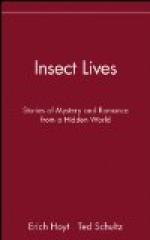PAST AND PRESENT; THE MEANING OF THE STORY
In the previous chapter we recognised how the seasonal changes in various species of butterflies as observable in two or three generations, indicate changes in the history of the race as it might be traced through innumerable generations. The endless variety in the form and habits of insect-larvae and their adaptations to various modes of life, which have been briefly sketched in this little book, suggest vaster changes in the class of insects, as a whole, through the long periods of geological time. Every student of life, influenced by the teaching of Charles Darwin (1859) and his successors, now regards all groups of animals from the evolutionary standpoint, and believes that comparisons of facts of structure and life-history of orders and classes evidently akin to each other, furnish at least some indications of the course of development in the greater systematic divisions, even as the facts of seasonal dimorphism, mentioned in the last chapter, give hints as to the course of development in those restricted groups that we call species or varieties. A brief discussion of the main outlines of the life-story of insects in the wide, evolutionary sense may thus fitly conclude this book.
In the first place we turn to the ‘records’ of those rocks, in whose stratified layers[12] are entombed remains, often fragmentary and obscure, of the insects of past ages of the earth’s history. Compared with the thousands of extinct types of hard-shelled marine animals, such as the Mollusca, fossil insects are few, as could only be expected, seeing that insects are terrestrial and aerial creatures with slight chance of preservation in sediments formed under water. Yet a number of insect remains are now known to naturalists, who are, in this connection, more particularly indebted to the researches of S.H. Scudder (1885), C. Brongniart (1894), and A. Handlirsch (1906).
[12] See Table of Geological Systems, p. 123.
We are now considering insects from the standpoint of their life-histories, and the individual life-story of an insect of which we possess but a few fragments of wings or body, entombed in a rock formed possibly before the period of the Coal Measures, can only be a matter of inference. Still it may safely be inferred that when the structure of these remains clearly indicates affinity to some existing order or family, the life-history of the extinct creature must have resembled, on the whole, that of its nearest living allies. And all the fossil insects known can be either referred to existing orders, or shown to indicate definite relationship to some existing group.




